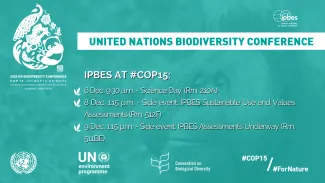
What Is Transformative Change, and How Do We Achieve It?
What Is Transformative Change, and How Do We Achieve It?: Think Globally Act Locally
November 2019 guest blog by Kai Chan, Global Assessment Coordinating Lead Author
The IPBES Global Assessment woke up the world to the negative consequences of our current trajectory of human impact on nature, and to the required solution: transformative change. This message has spread like wildfire, with many of the authors of the Report still receiving regular media and briefing requests, even months after its launch. One key question arises again and again, “What does transformative change mean, and how do we get started?”
Transformative change means doing things differently—not just a little more or less of something we’re already doing.
Of course, we should keep up many of the good things we’re doing—recycling, composting, cycle-commuting, taking public transit, etc. Those actions are all helpful, and they are among the foundations of transformative change.
But truly transformative change is change that becomes sweeping. It often starts small, but it is strategic. It includes individual decisions to help start or build new social norms, and the legal changes that unlock all kinds of other change. Here are five steps YOU can take to enable transformative change towards sustainability, drawn directly from the IPBES Global Assessment’s findings. There’s a role for everyone in each of these, whether you are an individual, an organization, or a policymaker.
1. You could go carbon-neutral, and expect others and businesses to do the same. Leaders in communities and business are doing this. Governments are committing to it (in a decade or more). We can make it normal and eventually mandatory. We can reshape what’s seen as good (corporate) citizenship by saying, “No more! I/we will no longer contribute climate pollution to the atmosphere. I/we will ensure that what I/we contribute is soon negated by high quality legitimate offsets, where my money helps others do things in a substantially more climate-friendly way.” (Beware of cheap knock-offs—if it seems too cheap to be legitimate, you’re probably right). Or, “I will commit to doing this when I’m able.”
2. You can work to make it easy, enjoyable, inexpensive, and then normal to go Earth-positive. The Global Assessment made it clear that—as far as environmental problems go—climate change is just the tip of the iceberg. We need to worry about land and ocean use, over-exploitation, invasive species, and pollution including plastics—and all of their effects on nature and its contributions to people. It’s not yet possible for individuals and organizations to mitigate the diverse impacts we have on nature through our lifestyles and purchases, but we could make it possible.
A key goal could be bold shifts in supply chains and proactive legislation, but citizens can catalyze this change by demonstrating demand for transformative action. It is possible to to galvanize widespread support for conservation and mitigation action among consumers, donors, voters, and businesses, to show that change is technically possible and publicly desirable.
3. You could join the global calls to make all subsidies and incentives work for—not against—the transformation that is needed. In countless ways, governments and other organizations still give money to businesses and individuals to boost the extraction of resources and the production of goods. Most of these subsidies encourage production regardless of environmental stewardship, resulting in production that has considerable negative cumulative effects on nature and what it does for people. Such an approach may have made sense in the 19th Century, when economies were small, and the negative effects of production largely dissipated. It does not make sense in the 21st Century, when the cumulative effects of economic activities are sometimes delayed and diffuse but undeniable in their scope and magnitude.
One approach, therefore, is for voters to pressure governments to commit to all subsidies being conditional upon a high standard of environmental stewardship, moving towards net positive effects on nature and its contributions to humans. In the context of fossil fuels, this means ending current production-boosting subsidies (which indirectly enhance powerful lobbying efforts for their continuation). Instead, we can subsidize the graceful transition of workers and businesses away from oil, gas, and coal and towards clean, green energy.
4. You can insist that all decision-making should be precautionary, adaptive, inclusive and integrative across sectors and jurisdictions. While some governments and businesses are tackling emerging threats like climate change and plastic pollution proactively and adaptively, others are playing chicken with our climate and oceans, hiding behind excuses that definitive proof is lacking. But we don’t need definitive proof of any particular impact or process to take no-regret actions to address emerging risks. In many nations, the science is more than sufficient to justify much stronger action on climate and land-use change, over-harvest, invasive species, and pollution.
Voters, governments, and businesses can commit to pre-emptive decision-making that is robust to a range of possible futures. We can almost never know the future well enough for exhaustive proof to precede timely action. Pre-emptive, inclusive and robust decision-making means, for example:
(a) Restricting new chemicals until there is sufficient reason to believe that they are safe for people and the environment (as in Europe under REACH legislation);
(b) Governing via transparent and participatory processes involving all major stakeholder groups and rights-holders, without privileging powerful actors to special or secret access;
(c) Zoning as if, for instance,100-year floods may happen every decade (this is already happening in many places thanks to land-use and climate change); and
(d) Reducing emissions to limit climate change to at most 1.5C as aspired to under the Paris Agreement.
5. You could add your support to strengthen environmental laws and policies, and ensure the consistent enforcement of all laws and policies—at home and abroad. In many nations, it remains legal for businesses to derive profits from activities that have substantial cumulative negative effects on nature and people, locally and abroad, now and in the future. And where it isn’t legal, in many nations such actions take place regularly because of inconsistent enforcement. This sets up a global race to the bottom, where businesses compete for development that creates jobs at the expense of the environment and sustainable prosperity, locally and globally.
A global sustainable economy would be one where all economic activities nourish the planet, not degrade it. Voters, governments and businesses could commit to strengthening local environmental protections and—through supply chains and trade agreements—strengthening protections elsewhere. This can take the form of the human right to a clean and safe natural environment, and even the rights of nature (as in Bolivia and New Zealand, for example). It could include safeguarding species and ecosystems at risk, and assigning to producers the responsibility for producing goods that can safely be dismantled for legitimate recycling and reuse.
Sustainable futures are within our grasp, but only if we roll up our sleeves and do our part. Our responsibility does not require Herculean efforts to be saintly in our current flawed system, but rather to strategic and collective acts as both citizens and consumers to make it normal for everyone to sustain this planet that sustains us all.
Kai Chan is a professor at the University of British Columbia in the Institute for Resources, Environment and Sustainability. He was a Coordinating Lead Author for the IPBES Global Assessment. He is also a member of Canada’s Clean16 for 2020, and cofounder of CoSphere, a Community of Small-Planet Heroes, which aspires to make it easy, enjoyable and inexpensive for individuals and organizations to have net-positive impacts on nature
To read more by this author go to: http://chanslab.ires.ubc.ca/
Follow IPBES on social media.






